4.8: Stem-Changing Verbs
- Page ID
- 44553
In Spanish, infinitives are made up of two parts: The Stem & The Ending.
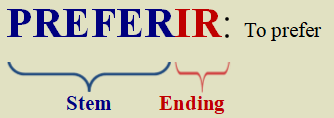
We are already very familiar with present tense verb endings—we know that every verb will end in –AR, -ER, or –IR, and that the endings for each group will change in the same way when the verb is conjugated.
The stem is everything up to the –AR, -ER, or –IR ending. We haven’t talked much about this part of the verb yet because the verbs we have seen thus far keep the original stem. However, there are many verbs in Spanish that see a slight change in the stem when the verb is conjugated, which we often refer to as Stem-Changing Verbs, Stem-Changers, or Boot Verbs.
When students first start learning to use Stem-Changers, they focus so much on the change in the stem that they often start to misuse endings. It is important to remember that our endings are going to continue to work just like they always do, so let’s review present tense endings.
-AR verbs get –AR endings.
-ER verbs get –ER endings.
–IR verbs get –IR endings.
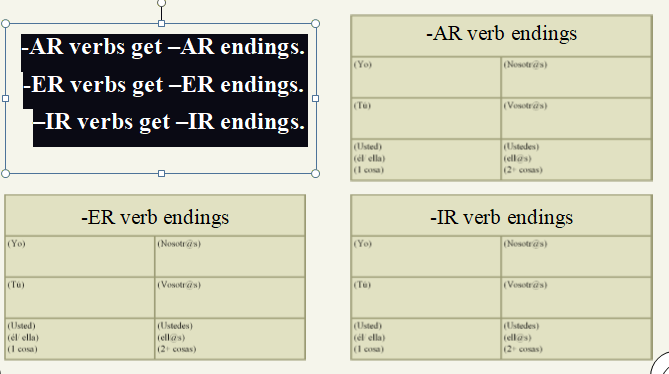
When students are initially learning to use these verbs, they wonder if there is some trick to identify them by the way they are spelled, or some other clue that can be found if you know where to look.
Unfortunately, there is no special way to identify them. You just have to know which verbs take a stem-change. How will you “just know” a certain verb stem-changes? Because you studied and practiced each of them… a lot.

Dormir (o:ue) —to sleep. El león duerme mucho. ¡Es un gato!
How to use Stem-Changing Verbs:
· The verb endings are the same as always.
· The last vowel of the stem changes when the verb is conjugated in all forms
EXCEPT nosotros & vosostros.
· Possible stem-changes are:
⇨ E to IE ⇨ E to I
⇨ O to UE ⇨ U to UE: There is only one verb that goes U to UE (jugar: to play)
When studying the new vocabulary, study the infinitive with the stem-change. It’s best to learn the meaning and the change simultaneously.
E to IE
Entender (e:ie)________
Pensar (e:ie)________
+ en_________________________________
Empezar (e:ie)________
+ a infinitivo________
Perder (e:ie)________
Preferir (e:ie)________
Querer (e:ie)________
Mentir (e:ie)________
O to UE
Dormir (o:ue)________
Poder (o:ue)________
Costar (o:ue)________
Encontrar (o:ue)________
Recordar (o:ue)________
No + recordar ________
Probar (o:ue)________
Volar (o:ue)________
E to I
Pedir (e:i)________
Servir (e:i)________
Repetir (e:i)________
Decir (e:i)*________
Seguir (e:i)*________
U to UE
Jugar (u:ue) ________
*These verbs also have an irregular yo form.

Sandra piensa mucho en la experiencia humana en su clase de filosofía

Mateo quiere comprar un reloj de pulsera.

Cuando viajo, pruebo alimentos nuevos.

Siempre pides el arroz con pollo. ¿Por qué no pruebas algo nuevo?
Actividad 23
¡A conjugar! Conjugate each of our reflexive verbs using the charts below. While filling out verb charts won’t make you fluent, it is a good way for us to see how these work before moving on.

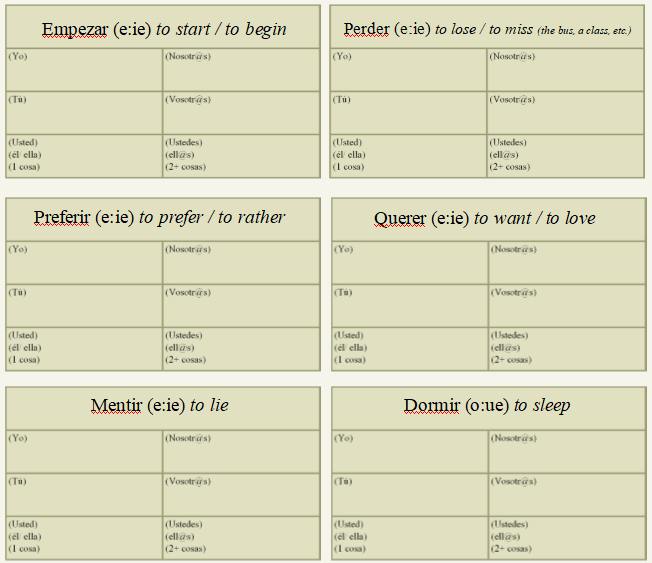
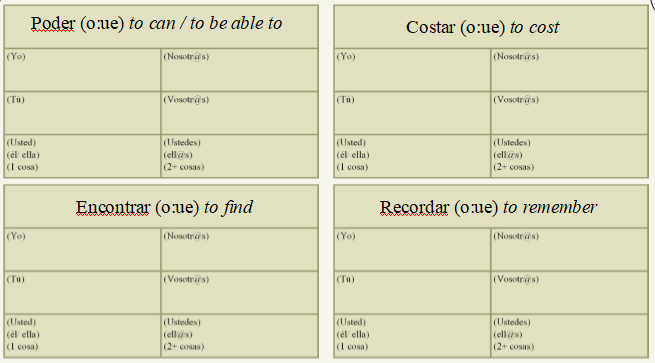
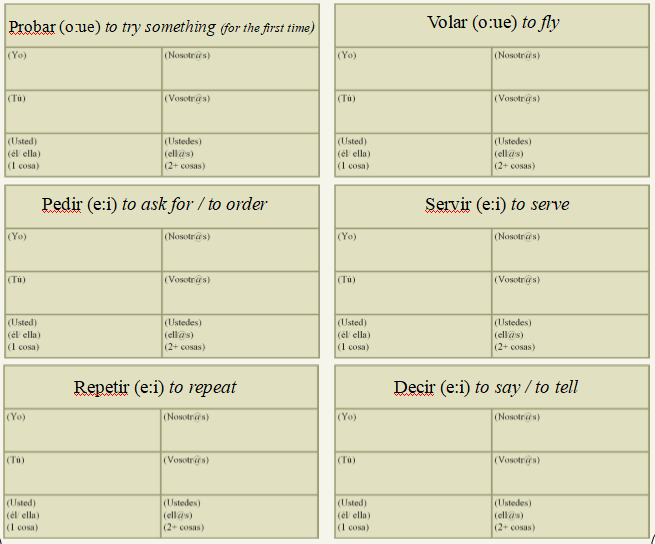

Actividad 24
Volar 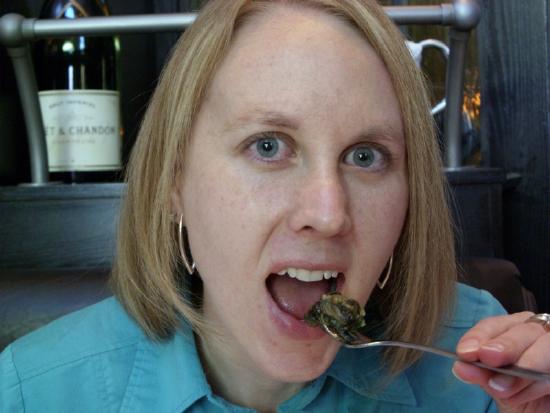 1.
1.
Servir  2.
2.
Probar  3.
3.
Jugar  4.
4.
Actividad 25
¿Qué dices? What would you say in the following situations? Draw a line to of the provided answers, or create one of your own. You may choose the same response more than one. Then, interview a partner.
1. ¿Qué dices si un desconocido* te pide un dólar? A stranger
2. ¿Qué dices si un amigo te dice muy buenas noticias?* good news
3. ¿Qué dices si tienes que repetir una clase?
4. ¿Qué dices si pierdes las llaves?* the keys
5. ¿Qué dices si encuentras las llaves?
6. ¿Qué dices si una person te sigue en la calle?* the street
7. ¿Qué dices si tu novi@ te miente mucho?
8. ¿Qué dices si encuentras veinte dólares en el bolsillo?* pocket
9. ¿Qué dices si tu pareja no recuerda tu cumpleaños?
10. ¿Qué dices si no entiendes la lección de español?
¡Ay, de mí!
· Poor me!
¡Basta!
· Enough!
¡Muchísimas gracias!
· Thank you so much!
¡Déjame (déjeme) en paz!
· Leave me alone!
¡Vete a freír espárragos!
· Get lost!
¡Qué suerte!
· How lucky!
¡Qué alegría!
· What joy!
Ten. / Tenga.
· Here you go.
No digo nada.
· I don’t say anything.
¡Socorro!
· Help! (emergency)

Actividad 26
¿Puedes o no puedes? The verb poder is used very frequently in Spanish. Answer the questions below as completely as possible about things you can and cannot do. Audio
1. ¿Puedes tocar el piano? ________
2. ¿Puedes cocinar bien?________
3. ¿Puedes hablar ruso?________
4. ¿Puedes ir al centro conmigo mañana?________
5. ¿Puedes jugar bien al fútbol?________
Actividad 27
Rellenar el espacio. Choose which verb fits best, then conjugate it based on the subject to complete the sentence.
1. Lalo ________ a su mamá porque no quiere meterse en problemas. (Mentir / Encontrar)
2. Santi le ________ la verdad a su mamá porque él sabe mejor. (Seguir / Decir)
3. ¿________ tú cómo llegar a la casa de Cristian y Angélica? (Encontrar / Recordar)
4. Verónica no ________ muy bien porque toma café muy tarde en el día. (Dormir / Poder)
5. Mi esposo y yo______________________ viajar a Sudamérica este verano. (Costar / Querer)
6. Usted ________ tocar el piano, ¿verdad? (Poder / Probar)
7. La profesora ________ las instrucciones. (Repetir / Servir)
8. Daniela y Pablo______________________ tamales para el almuerzo en la Navidad. (Decir/ Servir)
9. Mis hermanos y yo ________ al fútbol. (Jugar / Costar)



Actividad 28
Preguntas personales. Answer the following questions using Stem-Changing Verbs. Be sure to conjugate so that you will have a complete sentence! Then, interview a classmate in Spanish.
1. ¿Siempre recuerdas el cumpleaños de tu mamá? ________
________
2. Cuando vas de vacaciones, ¿vuelas o manejas a tu destino?________
________
3. Cuando tienes un examen, ¿cuándo empiezas a estudiar?________
________
4. ¿Juegas algún deporte?________
5. ¿Qué sirves para la cena en las ocasiones especiales?________
________
6. ¿Puedes tocar algún instrumento?________
Actividad 29
Submarino. The object of this game is to find the location of you classmate’s submarinos. First, draw four submarinos on your grid and keep them a secret from your partner. To guess a square on your partner’s grid, conjugate the Stem-Changing Verbs from the top row based on a subject given in the left-hand column. If there is a submarino in that square, your partner will say, “Lo acertaste” (you hit it). If there is no submarino, your partner will respond, “Lo fallaste” (you missed it). Take turns, and keep track of hits and misses on your grid. The first person to locate all four submarinos wins!
|
Pensar
|
Volar
|
Decir
|
Jugar
|
|
| Yo | ||||
| Tú | ||||
| Daniela | ||||
| Nosotros |
Actividad 30
¿Tiene usted mucha suerte? Respond to the questionnaire below to determine whether or not you are a lucky person. Score two points each time you answer siempre, one point each time you answer a veces, and zero points each time you answer nunca.
1. Yo sé dónde están mis llaves* (keys)…………………………..……..
2. Juego bien el veintiuno.……………………………………….….…..…
3. Encuentro dinero en la calle* (the street)…………………...………..
4. Recibo regalos para las ocasiones especiales.……….…….…………
5. Cuando vuelo, llego a tiempo a mi destino.……….……….…………
6. Siempre recibo lo que pido en un restaurante.………….……….……
7. Mis libros de texto cuestan menos de $250 por año.……..…………
8. Duermo lo suficiente.…………………………………………...……….
9. Puedo descansar los fines de semana. …………………………..….…
10. Mis amigos recuerdan llamarme el día de mi cumpleaños.…..……
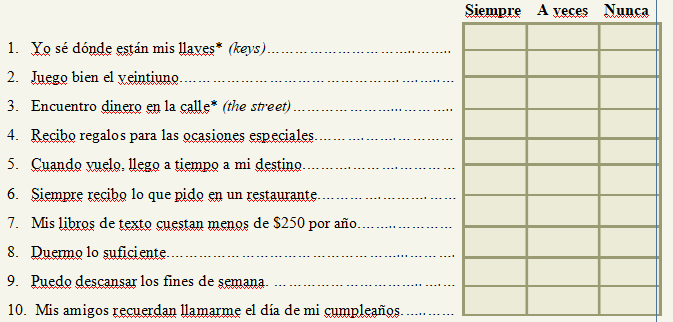
Si tiene entre 15 y 20 puntos, usted es una persona que tiene mucha suerte.
Hoy es un buen día para tomar un riesgo pequeño. Por ejemplo, usted puede pobrar una comida que nunca ha probado antes y ¡es probable que le vaya a gustar! También, si usted es una persona que apuesta, hoy puede ser un buen día para comprar un boleto de lotería.
Si tiene entre 8 y 14 puntos, usted es una persona normal.
Hoy es un buen día para tomar riesgos, pero también es buena idea tener un plan alternativo. Por ejemplo, usted puede comprar un nuevo sabor creativo de helado, pero sería buen plan también comprar su sabor favorito… en caso de que el nuevo no le guste.
Si tiene entre 0 y 7 puntos, usted es una persona que no tiene mucha suerte.
Eso no quiere decir que usted es una persona que tiene mala suerte, sino que la suerte no le ha tocado ya. Recuerde el refrán de “quien no arriesga, no gana”. Busque oportunidades para abrirse a lo inesperado de la vida.
Este cuestionario solo sirve para entretener; no se debe interpretarlo como consejos.
This questionnaire is only for entertainment, it should not be interpreted as advice.






